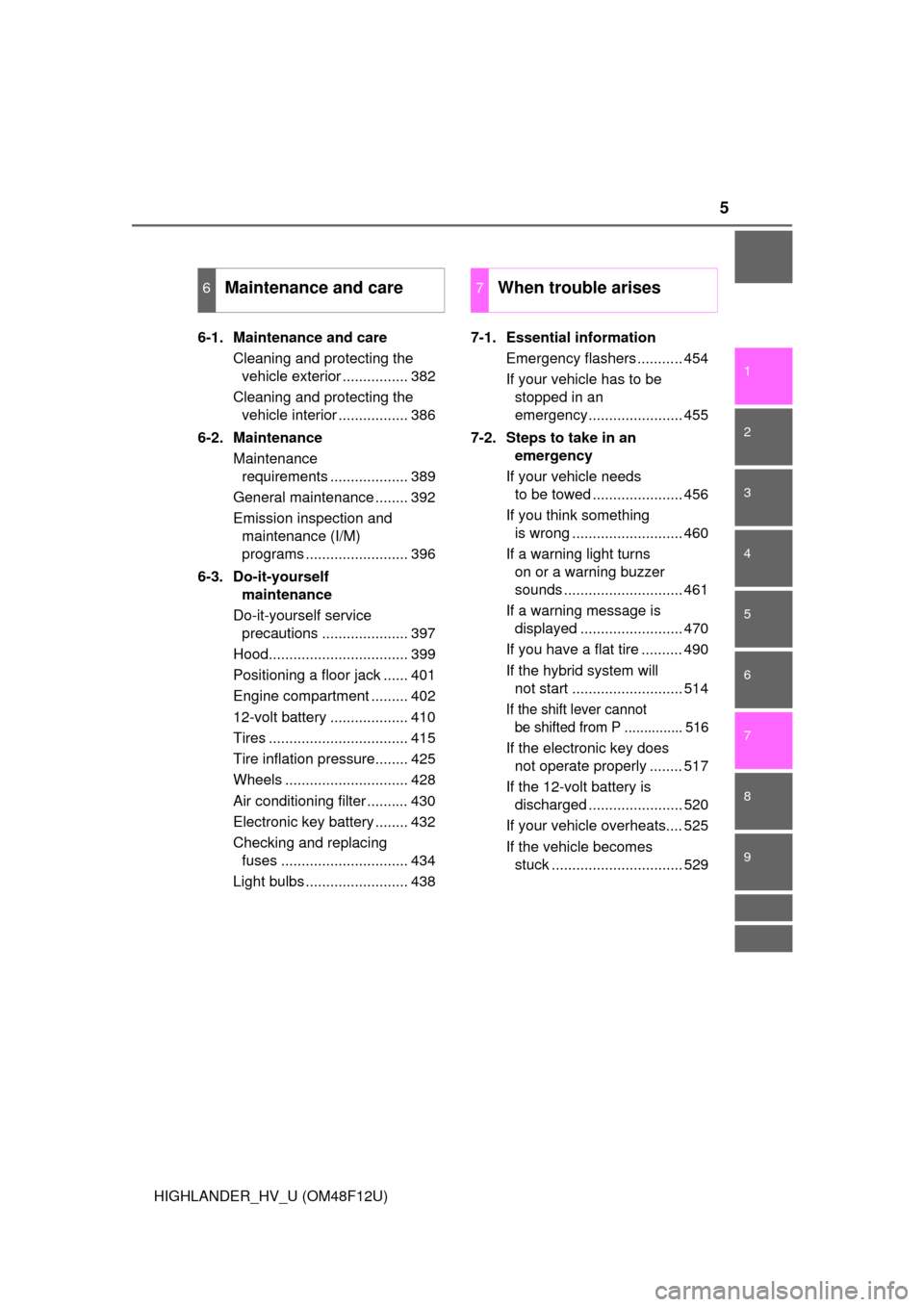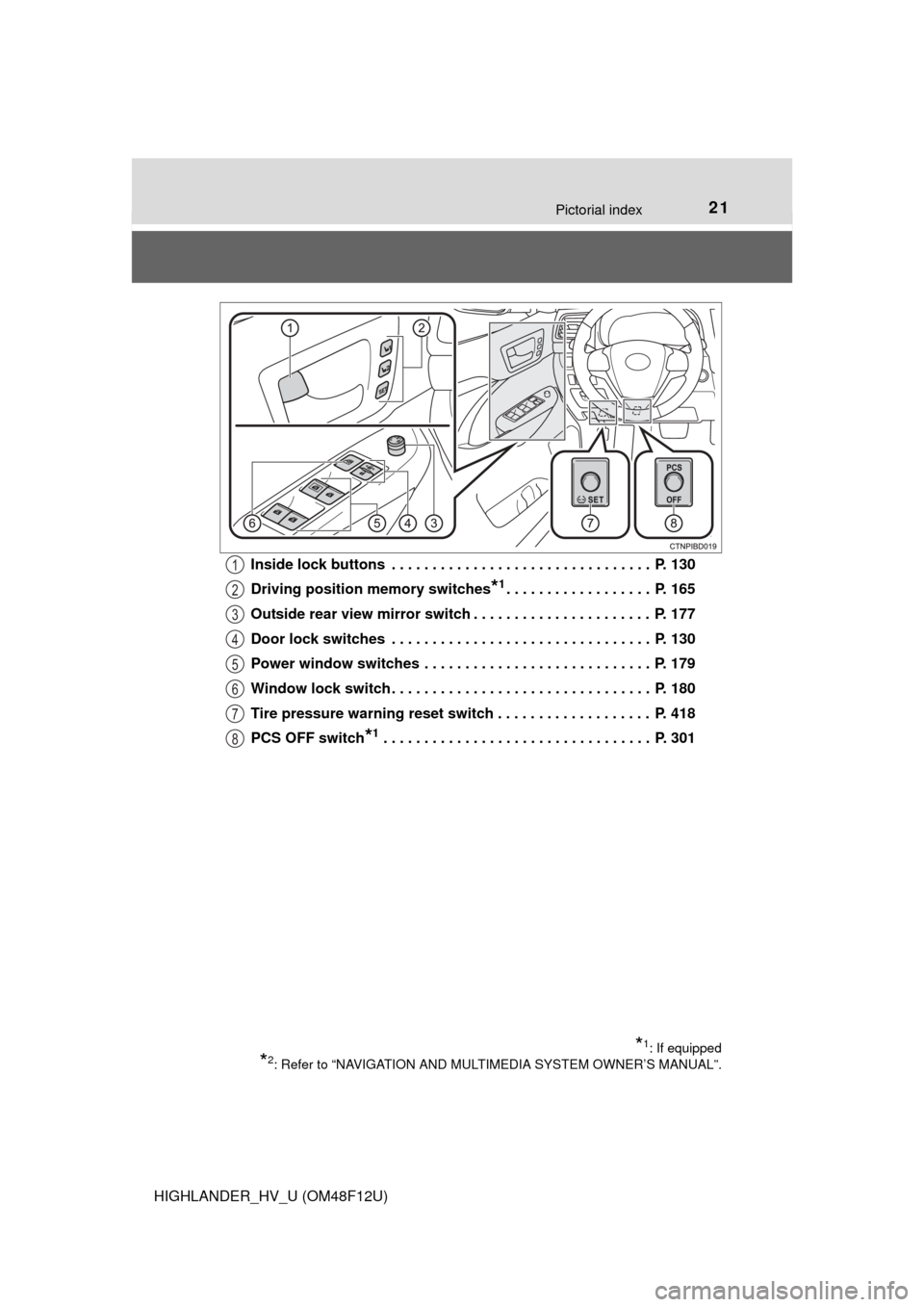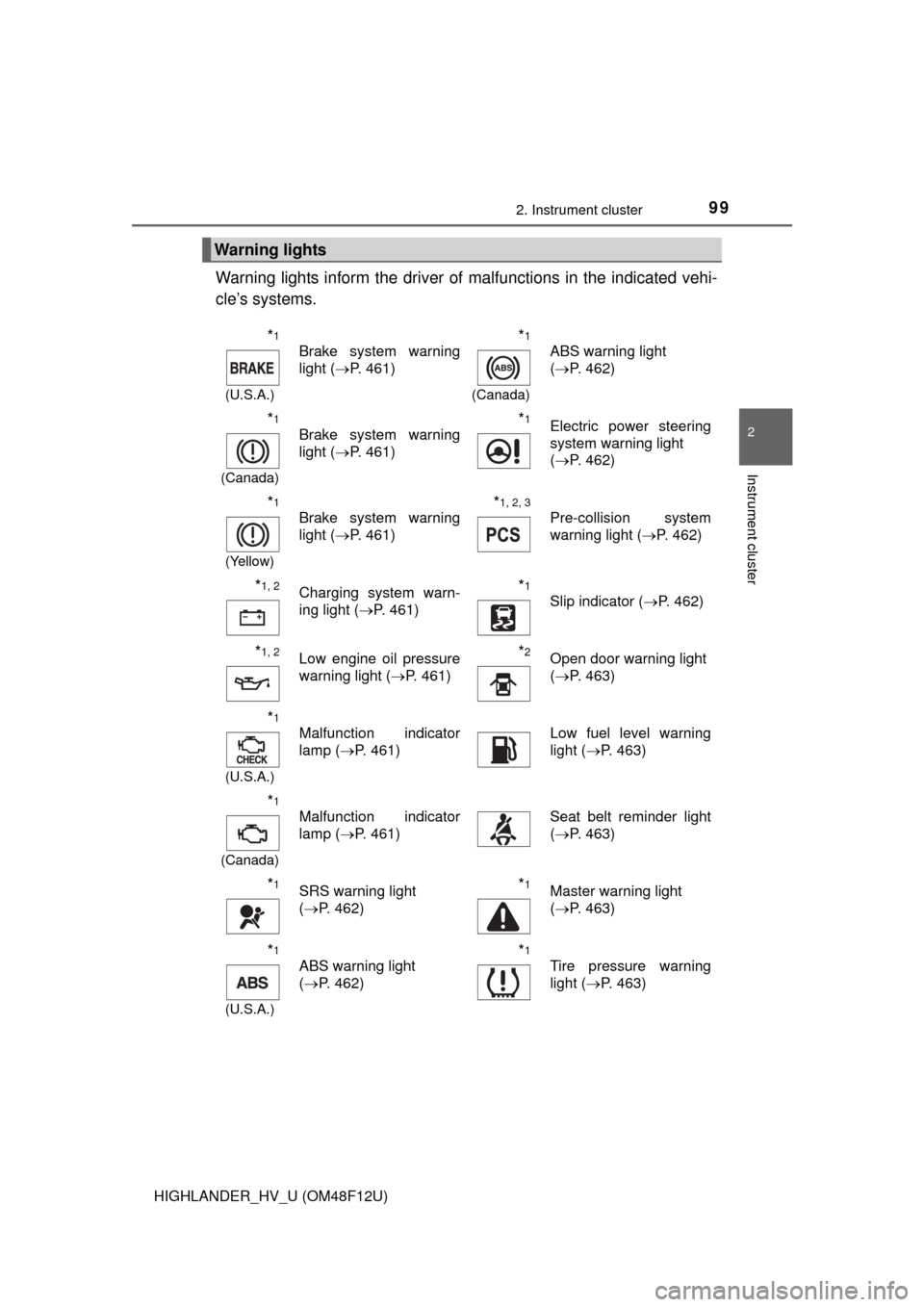2016 TOYOTA HIGHLANDER HYBRID tire pressure
[x] Cancel search: tire pressurePage 5 of 608

5
1
8 7
6
5
4
3
2
HIGHLANDER_HV_U (OM48F12U)
9
6-1. Maintenance and careCleaning and protecting the vehicle exterior ................ 382
Cleaning and protecting the vehicle interior ................. 386
6-2. Maintenance Maintenance requirements ................... 389
General maintenance ........ 392
Emission inspection and maintenance (I/M)
programs ......................... 396
6-3. Do-it-yourself maintenance
Do-it-yourself service precautions ..................... 397
Hood.................................. 399
Positioning a floor jack ...... 401
Engine compartment ......... 402
12-volt battery ................... 410
Tires .................................. 415
Tire inflation pressure........ 425
Wheels .............................. 428
Air conditioning filter .......... 430
Electronic key battery ........ 432
Checking and replacing fuses ............................... 434
Light bulbs ......................... 438 7-1. Essential information
Emergency flashers ........... 454
If your vehicle has to be stopped in an
emergency....................... 455
7-2. Steps to take in an emergency
If your vehicle needs to be towed ...................... 456
If you think something is wrong ........................... 460
If a warning light turns on or a warning buzzer
sounds ............................. 461
If a warning message is displayed ......................... 470
If you have a flat tire .......... 490
If the hybrid system will not start ........................... 514
If the shift lever cannot be shifted from P ............... 516
If the electronic key does not operate properly ........ 517
If the 12-volt battery is discharged ....................... 520
If your vehicle overheats.... 525
If the vehicle becomes stuck ................................ 529
6Maintenance and care7When trouble arises
Page 17 of 608

17Pictorial index
HIGHLANDER_HV_U (OM48F12U)Fuel filler door . . . . . . . . . . . . . . . . . . . . . . . . . . . . . . . . . . . . P. 261
Refueling method. . . . . . . . . . . . . . . . . . . . . . . . . . . . . . . . . . . P. 261
Fuel type/fuel tank capacity . . . . . . . . . . . . . . . . . . . . . . . . . . . P. 535
Tires . . . . . . . . . . . . . . . . . . . . . . . . . . . . . . . . . . . . . . . . . . . . P. 415
Tire size/inflation pressure . . . . . . . . . . . . . . . . . . . . . . . . . . . . P. 540
Winter tires/tire chain . . . . . . . . . . . . . . . . . . . . . . . . . . . . . . . . P. 319
Checking/rotation/tire pressure warning system . . . . . . . . . . . P. 415
Coping with flat tires . . . . . . . . . . . . . . . . . . . . . . . . . . . . . . . . P. 490
Hood . . . . . . . . . . . . . . . . . . . . . . . . . . . . . . . . . . . . . . . . . . . . P. 399
Opening . . . . . . . . . . . . . . . . . . . . . . . . . . . . . . . . . . . . . . . . . . P. 399
Engine oil . . . . . . . . . . . . . . . . . . . . . . . . . . . . . . . . . . . . . . . . . P. 536
Coping with overheat . . . . . . . . . . . . . . . . . . . . . . . . . . . . . . . . P. 525
Warning messages . . . . . . . . . . . . . . . . . . . . . . . . . . . . . . . . . P. 473
Headlights/daytime running lights . . . . . . . . . . . . . . . . . . . . P. 244
Front fog lights. . . . . . . . . . . . . . . . . . . . . . . . . . . . . . . . . . . . P. 254
Turn signal lights . . . . . . . . . . . . . . . . . . . . . . . . . . . . . . . . . . P. 242
Stop/tail lights . . . . . . . . . . . . . . . . . . . . . . . . . . . . . . . . . . . . P. 244
Hill-start assist control . . . . . . . . . . . . . . . . . . . . . . . . . . . . . . . P. 295
License plate lights . . . . . . . . . . . . . . . . . . . . . . . . . . . . . . . . P. 244
Back-up lights
Shifting the shift lever to R . . . . . . . . . . . . . . . . . . . . . . . . . . . . P. 237
Side marker lights . . . . . . . . . . . . . . . . . . . . . . . . . . . . . . . . . P. 244
6
7
8
Light bulbs of the exterior lights for driving
(Replacing method: P. 438, Watts: P. 543)
*: If equipped
9
10
11
12
13
14
15
Page 21 of 608

21Pictorial index
HIGHLANDER_HV_U (OM48F12U)Inside lock buttons . . . . . . . . . . . . . . . . . . . . . . . . . . . . . . . . P. 130
Driving position memory switches
*1. . . . . . . . . . . . . . . . . . P. 165
Outside rear view mirror switch . . . . . . . . . . . . . . . . . . . . . . P. 177
Door lock switches . . . . . . . . . . . . . . . . . . . . . . . . . . . . . . . . P. 130
Power window switches . . . . . . . . . . . . . . . . . . . . . . . . . . . . P. 179
Window lock switch . . . . . . . . . . . . . . . . . . . . . . . . . . . . . . . . P. 180
Tire pressure warning reset switch . . . . . . . . . . . . . . . . . . . P. 418
PCS OFF switch
*1 . . . . . . . . . . . . . . . . . . . . . . . . . . . . . . . . . P. 301
*1: If equipped
*2: Refer to “NAVIGATION AND MULTIMEDIA SYSTEM OWNER’S MANUAL”.
1
2
3
4
5
6
7
8
Page 99 of 608

992. Instrument cluster
2
Instrument cluster
HIGHLANDER_HV_U (OM48F12U)
Warning lights inform the driver of malfunctions in the indicated vehi-
cle’s systems.
Warning lights
*1
(U.S.A.)
Brake system warning
light ( P. 461)*1
(Canada)
ABS warning light
(P. 462)
*1
(Canada)
Brake system warning
light ( P. 461)*1Electric power steering
system warning light
(P. 462)
*1
(Yellow)
Brake system warning
light ( P. 461)*1, 2, 3
Pre-collision system
warning light ( P. 462)
*1, 2Charging system warn-
ing light (P. 461)*1
Slip indicator ( P. 462)
*1, 2Low engine oil pressure
warning light (P. 461)*2Open door warning light
(P. 463)
*1
(U.S.A.)
Malfunction indicator
lamp ( P. 461)Low fuel level warning
light (P. 463)
*1
(Canada)
Malfunction indicator
lamp ( P. 461)Seat belt reminder light
(P. 463)
*1SRS warning light
(P. 462)*1Master warning light
(P. 463)
*1
(U.S.A.)
ABS warning light
(P. 462)*1
Tire pressure warning
light ( P. 463)
Page 291 of 608

2914-5. Using the driving support systems
4
Driving
HIGHLANDER_HV_U (OM48F12U)■
Conditions in which the function may not operate correctly
In the following situations, the camera sensor may be unable to recognize
lane markers causing the lane departure warning function to operate incor-
rectly. However, this does not indicate a malfunction.
●When driving through an area with no lane markers, such as a tollbooth, a
crossing or before a ticket checkpoint
● When driving on a sharp curve
● When lane markers are extremely narrow or extremely wide
● When the vehicle leans to one side an unusual amount due to a heavy load
or improper tire inflation pressure
● When the following distance between your vehicle and the vehicle ahead is
extremely short
● When the lane markers are yellow (These may be more difficult for the sys-
tem to recognize compared to white markers.)
● When the lane markers are broken, Botts’ dots (raised pavement markers)
or stones
● When the lane markers are on a curb etc.
● When lane markers are obscured or partially obscured by sand, dirt, etc.
● When there are shadows on the road running parallel with lane markers, or
if a shadow covers the lane markers
● When driving on a particularly bright road surface, such as concrete
● When driving on a road surface that is bright due to reflected light
● When driving in a location where the light level changes rapidly, such as the
entrance to or exit from a tunnel
● When sunlight or the headlights of oncoming vehicles are shining directly
into the camera lens
● When driving on roads that are branching or merging
● When driving on a road surface that is wet due to rain, previous rainfall,
standing water, etc.
● When the vehicle experiences strong up-and-down motion such as when
driving on an extremely rough road or on a seam in the pavement
● When headlight brightness at nighttime is reduced due to dirt on the lenses,
or when the headlights are misaligned
● When driving on winding roads or roads that are uneven
● When driving on rough or unpaved roads
■ When changing the tires
Depending on the tires used, sufficient performance may not be maintainable.
■ Warning messages for the LDA system
Warning messages are used to indicate a system malfunction or to inform t\
he
driver of the need for caution while driving. ( P. 477)
Page 299 of 608

2994-5. Using the driving support systems
4
Driving
HIGHLANDER_HV_U (OM48F12U)
WARNING
■TRAC may not operat e effectively when
Directional control and power may not be achievable while driving on slip-
pery road surfaces, even if the TRAC system is operating.
Drive the vehicle carefully in conditions where stability and power may be
lost.
■ Hill- start assist control
●Do not overly rely on hill-start assist control. Hill-start assist control may
not operate effectively on steep inclines and roads covered with ice.
● Unlike the parking brake, hill-start assist control is not intended to hold the
vehicle stationary for an extended period of time. Do not attempt to use
hill-start assist control to hold the vehicle on an incline, as doing so may
lead to an accident.
■ When the VSC is activated
The slip indicator light flashes. Always drive carefully. Reckless driving may
cause an accident. Exercise particular care when the indicator light flashes.
■ When the TRAC/VSC syst ems are turned off
Be especially careful and drive at a speed appropriate to the road condi-
tions. As these are the systems to help ensure vehicle stability and driving
force, do not turn the TRAC/VSC systems off unless necessary.
■ Replacing tires
Make sure that all tires are of the specified size, brand, tread pattern and
total load capacity. In addition, make sure that the tires are inflated to the
recommended tire inflation pressure level.
The ABS, TRAC and VSC systems will not function correctly if different tires
are installed on the vehicle.
Contact your Toyota dealer for further information when replacing tires or
wheels.
■ Handling of tires and the suspension
Using tires with any kind of problem or modifying the suspension will affect
the driving assist systems, and may cause a system to malfunction.
Page 318 of 608

3184-6. Driving tips
HIGHLANDER_HV_U (OM48F12U)■
Air conditioning
Use the air conditioning only when
necessary. Doing so can help
control excessive gasoline consumption.
In summer: In high temperatures, use the recirculated air mode.
Doing so will help to reduce the burden on the air conditioner and
reduce fuel cons umption as well.
In winter: Because the gasoline eng ine will not automatically cut out
until the gasoline engine and the in terior of the vehicle are warm, it
will consume fuel. Also, fuel consumption can be improved by
avoiding overuse of the heater.
■Checking tire inflation pressure
Make sure to check the tire infl ation pressure frequently. Improper
tire inflation pressure can cause poor fuel consumption.
Also, as snow tires can cause large amounts of friction, their use on
dry roads can lead to poor fuel co nsumption. Use a tire that is
appropriate for the season.
■Luggage
Carrying heavy luggage can lead to poor fuel consumption. Avoid
carrying unnecessary luggage. Insta lling a large roof rack can also
cause poor fuel consumption.
■Warming up before driving
Since the gasoline engine starts up and cuts out automatically
when cold, warming up the engine is unnecessary. Moreover, fre-
quently driving short distances will cause the engine to repeatedly
warm up, which can lead to poor fuel consumption.
Page 322 of 608

3224-6. Driving tips
HIGHLANDER_HV_U (OM48F12U)
WARNING
■Driving with snow tires
Observe the following precautions to reduce the risk of accidents.
Failure to do so may result in a loss of vehicle control and cause death or
serious injury.
●Use tires of the specified size.
● Maintain the recommended level of air pressure.
● Do not drive in excess of 75 mph (120 km/h), regardless of the type of
snow tires being used.
● Use snow tires on all, not just some wheels.
■ Driving with tire chains
Observe the following precautions to reduce the risk of accidents.
Failure to do so may result in the vehicle being unable to be driven safely,
and may cause death or serious injury.
●Do not drive in excess of the speed limit specified for the tire chains being
used, or 30 mph (50 km/h), whichever is lower.
● Avoid driving on bumpy road surfaces or over potholes.
● Avoid sudden acceleration, abrupt steering, sudden braking and shifting
operations that cause sudden engine braking.
● Slow down sufficiently before entering a curve to ensure that vehicle con-
trol is maintained.
● Vehicles with LDA (Lane Departure Alert) system: Do not use LDA (Lane
Departure Alert) system.
NOTICE
■Repairing or replacing snow tires
Request repairs or replacement of snow tires from Toyota dealers or legiti-
mate tire retailers.
This is because the removal and attachment of snow tires affects the opera-
tion of the tire pressure warning valves and transmitters.
■ Fitting tire chains
The tire pressure warning valves and transmitters may not function correctly
when tire chains are fitted.